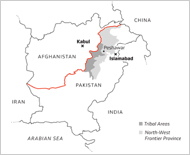Whose side is Pakistan on in the NATO-led conflict in Afghanistan? Does the Pakistani government and army want to stop and defeat the Taliban? Can it? As a US decision maker, should you be extremely worried about Pakistan's answers to all of these questions? Unfortunately, the last question is the only one that should be answered with an authoritative Yes. With US/NATO drones flying in and out of Pakistan/Afghan's border region, the Taliban ramping up their activity throughout Afghanistan and Pakistan, including in the cities of Kabul and Peshawar, and with a new, untested government in place in Pakistan, we seek answers to these very important questions.
Dexter Filkins has written an excellent report full of first-hand stories, interviews, and analysis from the Afghan/Pak border region and he tries to answer these questions. Filkins, who just finished a book about his experience in Iraq ('the Forever War’), sees a border situation much like most observers nowadays, academic and in the press, violent, out of control, and maybe most disturbing, they all see a Pakistani government and army either unable to curtail the Taliban-led insurgents and Al Qaeda operatives in any meaningful way or even worse, actually providing support for the insurgency. Through interviews of Taliban members, tribal leaders around the border, militants, and Pak government officials Filkins paints a frightening, but all too real picture of a do-nothing Pak government, taking all the aid the US will throw at them while tacitly and at times implicitly supporting the Taliban's efforts to destabilize Afghanistan's government.
 Filkins goes over the deals made between the Pak army and the Taliban (he argues that these are the only pacts that can be made as the government is too impotent to be considered a real partner) and comes to the conclusion that they basically have come down to this: you (the border insurgents) don't attack Pakistan's mainland and cities, and we (the Pak army) will let you continue your attacks on NATO and Afghan forces across the border. Now the Pakistan government and army have denied this claim for years now, but as US/NATO increase its missions near the border and drone attacks keep hitting targets inside Pakistan, one has to believe that the US has started to take this as the truth and unilaterally respond as seen necessary. These aggressive attacks inside of Pakistani territory have caused a diplomatic riff that will hopefully just stay that way and not escalate. Chairman of the Joint Chiefs of Staff Mike Mullen flew to Pakistan today to meet with Pak civilian and military leadership. This is Mullen's fifth trip already to the nation since being named Chairman. The meeting will no doubt discuss US troop deployment into Pak territory on Sept. 3 and Pakistan's army chief Kayani response asserting their right to protect their homeland with force.
Filkins goes over the deals made between the Pak army and the Taliban (he argues that these are the only pacts that can be made as the government is too impotent to be considered a real partner) and comes to the conclusion that they basically have come down to this: you (the border insurgents) don't attack Pakistan's mainland and cities, and we (the Pak army) will let you continue your attacks on NATO and Afghan forces across the border. Now the Pakistan government and army have denied this claim for years now, but as US/NATO increase its missions near the border and drone attacks keep hitting targets inside Pakistan, one has to believe that the US has started to take this as the truth and unilaterally respond as seen necessary. These aggressive attacks inside of Pakistani territory have caused a diplomatic riff that will hopefully just stay that way and not escalate. Chairman of the Joint Chiefs of Staff Mike Mullen flew to Pakistan today to meet with Pak civilian and military leadership. This is Mullen's fifth trip already to the nation since being named Chairman. The meeting will no doubt discuss US troop deployment into Pak territory on Sept. 3 and Pakistan's army chief Kayani response asserting their right to protect their homeland with force.
It appears that both the US and Pakistan are playing a Double Game: Pakistan is taking US money and promising to reign in the Taliban, Al Qaeda, and other extremist forces that are causing instability in Afghanistan while at the same time in many ways willfully allowing the Taliban to control large swaths of territory and perform raids into Afghan territory. The US double game is more out in the open and its objectives are easier to discern: The US government continues to call the Pakistan government a partner in the War on Terror and provide it aid (such as these F-16's), while at the same time acknowledging that ISI helped orchestrate the Kabul Indian Embassy bombing and that large regions in and around the FATA were breeding and staging grounds for the Taliban, and in the last few weeks start to launch military missions inside of Pak territory without complete Pak government or military approval.
This is a very complicated issue and region of the world, and I know this piece, just like Filkins’ article, raised more questions than answers. Before you can win a war you have to know who your enemy is. We know a lot about the Taliban, they are the ones who burn girls’ schools, banish women from the street, blow up stores selling modern goods, and 'thrash children for flying kites,’ but what are the forces behind them? Who exactly are we fighting over there? Who are our friends? These are simple questions with complicated, troubling, and in many ways unknown, answers.
(Map Source: New York Times)